A few weeks ago, my fiancée received her restored Sagara watch that belonged to her grandfather from watchmaker and restorer Dr. Rebecca Struthers. Around the same time as the watch came back to us, Rebecca was kind enough to send us both an invitation to attend an event at the Royal Academy of Engineering in London to attend the launch event for Clocktime – a new digital museum.
Clocktime is a passion project from inventor Dr. John C Taylor OBE FREng, who is also a widely respected horologist and collector. The concept is to make a whole host of rare and important timepieces from yesteryear accessible online, raising awareness of these important artefacts amongst a new audience, and inspire an appreciation of traditional watchmaking and clockmaking skills to try and help preserve these for generations to come.
After all, if young people don’t know that something like this exists, they can never aspire to get involved themselves.
The event also included a panel discussion entitled “The Science and Art of Making Time” and was set to host eight incredibly special pieces which were shipped all the way from the Isle of Man just for this event, including a longcase clock made by John Harrison which was the most accurate clock in the world for an incredible 150 years – an opportunity not to be missed!
Who is Dr. John C Taylor OBE FREng?
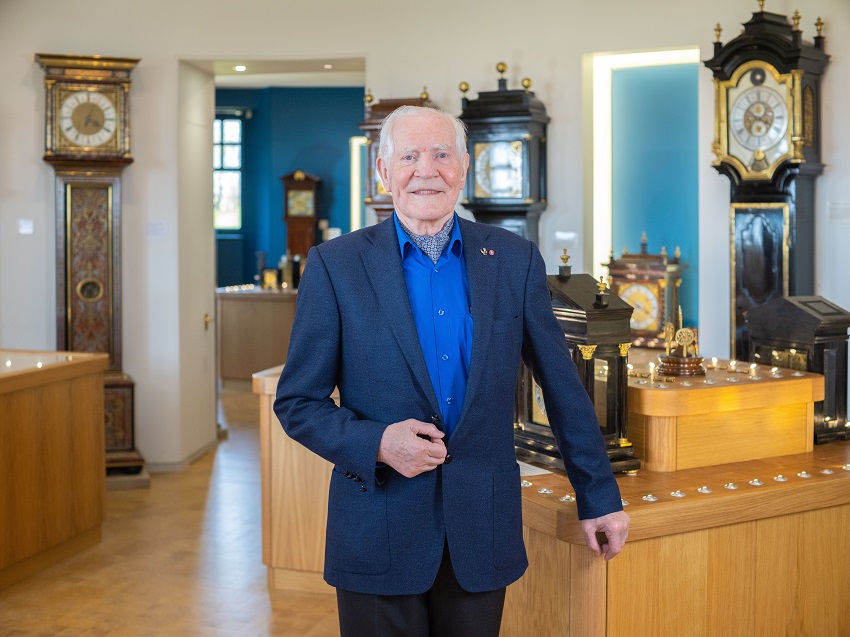
Dr John C Taylor OBE in his collection room of early English clocks – photo, Fromanteel Ltd
Clocktime is the brainchild of Dr. John C Taylor OBE FREng, who is a world-renowned inventor and horologist. In fact, there is a high likelihood that you have benefited from using his most famous invention within the last few hours in your own home: amongst his 400+ patents, is the bi-metallic controller which is used to switch off kettles when they reach boiling point!
Over his incredible career, he created many inventions that are still used today, and in 2011 was appointed as a Fellow to the Royal Academy of Engineering, as well as receiving an OBE in the New Year Honours for his services to business and horology.
He also counts himself as a recipient of the Harrison Medal from the Worshipful Company of Clockmakers for excellence in horology.
You might wonder what the link is between kettle controls and horology… well, Dr. Taylor views the clock as mankind’s most important invention, and so has a particular affinity for watchmaking and clockmaking, given they have such a unique place spanning both artistry and engineering. Over the course of 30 years, Dr. Taylor has amassed an incredible collection of early British watches and clocks, and other scientific instruments.
And of course, as an inventor and lover of all things horological, it’s perhaps unsurprising that he invented a special “Chronophage” clock, but more on that later…
Dr. Taylor is also a very generous philanthropist, having made multiple donations to support engineers in the UK, ensuring that budding engineers have the resources available to reach their potential. It is through this spirit of philanthropy that Clocktime has been launched – Dr. Taylor’s way of sharing this collection and passion with the world, creating an online resource which is accessible to everyone for years to come.
Clocktime Digital Museum
The digital museum can be visited at Clocktime.co.uk, and I highly recommend setting some time aside to explore it properly. You’ll find a huge number of exhibits and an absolute wealth of horological information and history – the amount of content available is really quite astonishing, and you can tell it has been a real labour of love to bring Clocktime to life.
The online exhibits are split out into important watches and clocks, and people. At the time of writing, these include 24 clock exhibits, 5 watches, and nearly 60 people including the likes of Christiaan Huygens, Thomas Tompion, Thomas Mudge and John Harrison. There are also more than 50 videos across the exhibits, with Dr. Taylor himself talking about the pieces on show, including their design, the movements inside, the people who made them, and the historic context from which they emerged.
Creating all of this took Dr. Taylor and his team eight years to complete.
One of my favourite details on the site is that whenever a page loads with the watches or clocks, the thumbnails of the pieces come to life, and actually advance as they do in real life to show the local time of where you are accessing the museum from! This means you get to see the hands and complications in action, and of course any that catch your eye you can immediately check out the exhibit and learn more about it.
I think this is a novel way of showing the exhibits online, and a clever way of bringing them to life in place of otherwise still photographs.
In terms of learning about horological history, there is also a timeline page, which details 99 key moments, events and inventions spanning the period from 3500BC right up until Greenwich Meridian Time was adopted worldwide in 1884. Of course, each of these key milestones has its own exhibit article, too, should you wish to learn more about it.
The team have done a wonderful job in creating Clocktime, and I would encourage anybody keen to learn more about horology to take a look.
Clocktime Launch Event
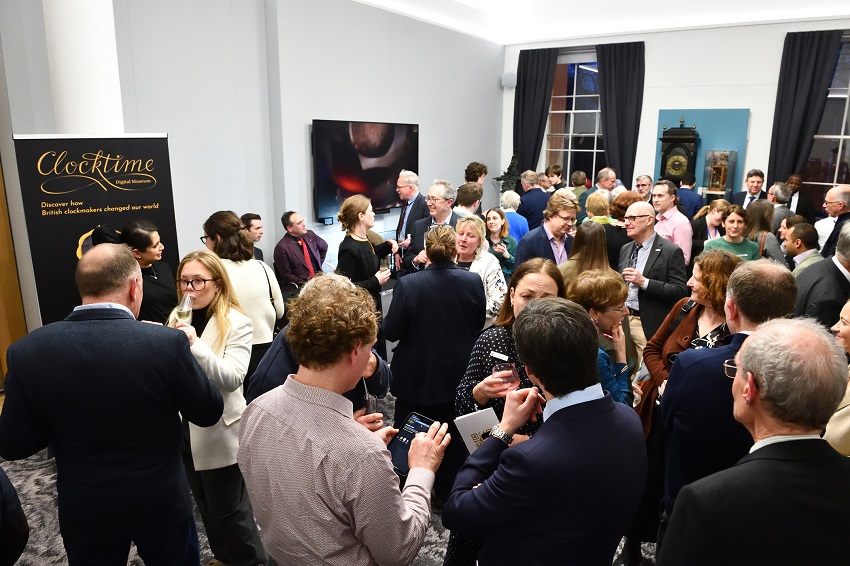
Clocktime Digital Museum launch event – photo, Fromanteel Ltd
When we arrived at the event, the main room was already super busy which was great to see! We grabbed a drink and slowly made our way around the eight exhibits which had been shipped over for one day, just for this event. This was an incredibly generous act, and it wasn’t lost on me just how incredible an opportunity it was to be able to see clocks and watches like these up close; the team had also taken the time to extract the moving parts from the longcase clocks such that you could see the mechanisms otherwise normally hidden away.
With the smaller clocks, you could see through the side of the pieces to the geartrains, and with the pocket watches you could admire the intricate hand engravings up close. With the exception of the John Harrison longcase clock, which is dated around 1726, all the other pieces were from the 1600s – I think it’s amazing to think that they were all around 400 years old.
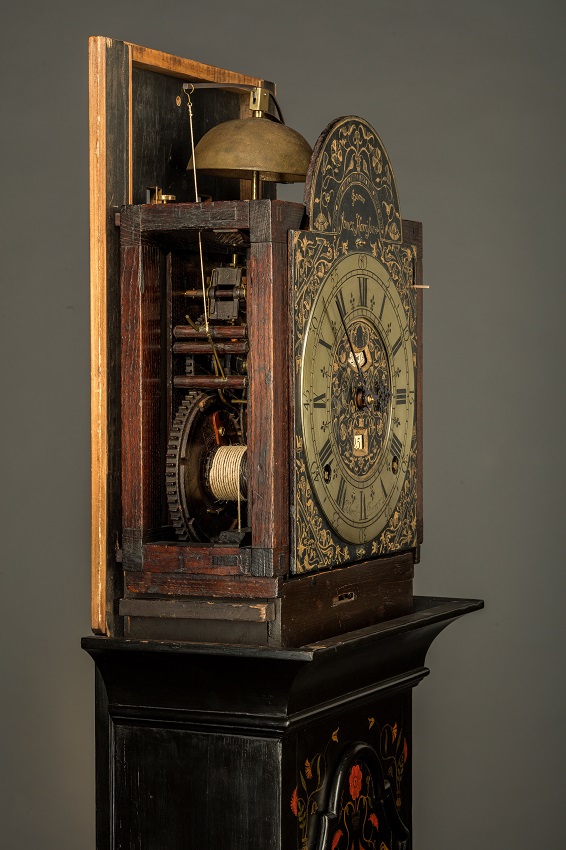
John Harrison Wooden Regulator dated 1726 – photo, © The John C Taylor Collection Limited
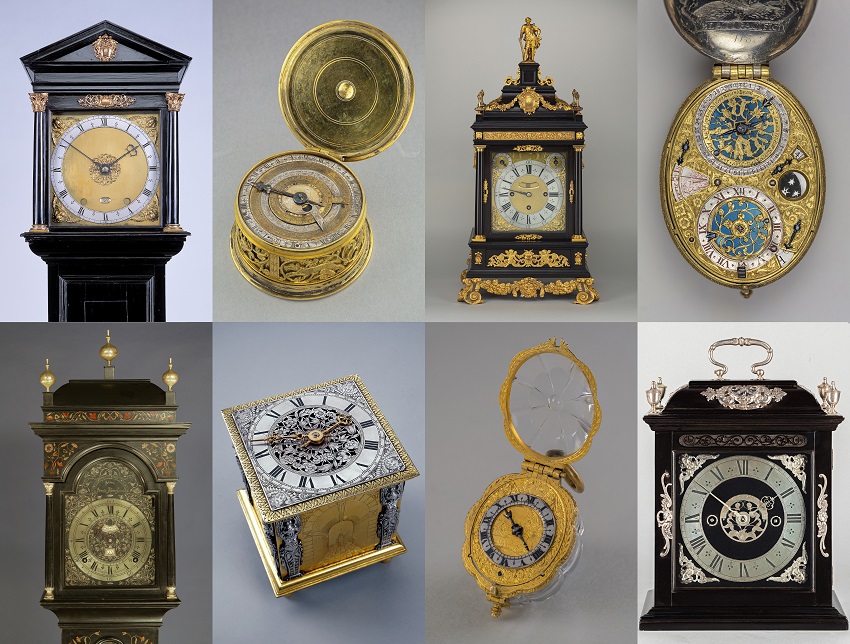
The clocks and watches on display at the Clocktime Digital Museum launch event – photo, Fromanteel Ltd
An unexpected delight for me was the ambience of the night being punctuated by chiming/striking clocks, adding a somewhat unexpected acoustic element to the experience.
In addition to the exhibits on display, there were a couple of stands showcasing the works of makers such as antiquarian horologist Seth Kennedy, and watchmakers Justin Koullapis and Scott Miller. There was also a series of videos on loop on a big screen, one of which was a “Chronophage” clock which caught my eye. This was a large mechanical clock with a huge, creepy-looking grasshopper on the top, and the video showed a little of the process behind creating the clock. It left me wanting to know more, and luckily, I wouldn’t have to wait too long!
Just before the panel discussion, we spotted Rebecca Struthers across the room and went to say hello – it was lovely to be able to meet her in person, and even more so for my fiancée to be able to thank her for what she had done in restoring her grandfather’s watch.
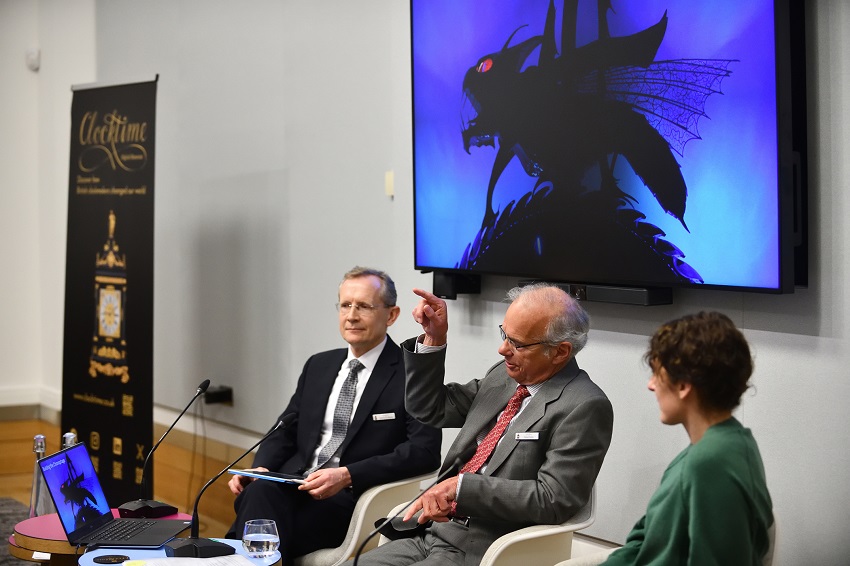
Prof Tim Minshall, Stuart Huxley and Dr Rebecca Struthers speaking at "The Science and Art of Making Time" – photo, Fromanteel Ltd
Soon after, the panel discussion began. Entitled “The Science and Art of Making Time”, panellists Stuart Huxley and Rebecca Struthers were guided by Professor Tim Minshall, each sharing a fascinating look at what goes into the making processes of large and small. The discussion started on a large scale with Stuart Huxley talking about the journey in creating the “Chronophage” clocks with Dr. Taylor, and then Rebecca Struthers talking about her career and Struthers Watchmakers, the business she runs alongside husband Craig, culminating in their own 248 in-house movement.
I was intrigued by the “Chronophage” clocks; they aren’t something I was previously aware of, but I really enjoyed hearing the story behind them and the effort that went into all the smaller details. Whilst there are four “Chronophage” clocks in existence, two are on public display in Cambridge, whilst the others are in private collections, including one at the home of Dr. Taylor! If I ever visit Cambridge, I’ll certainly make the effort to see these clocks, and I know that after having attended this event I’ll be able to better appreciate them for what they are.
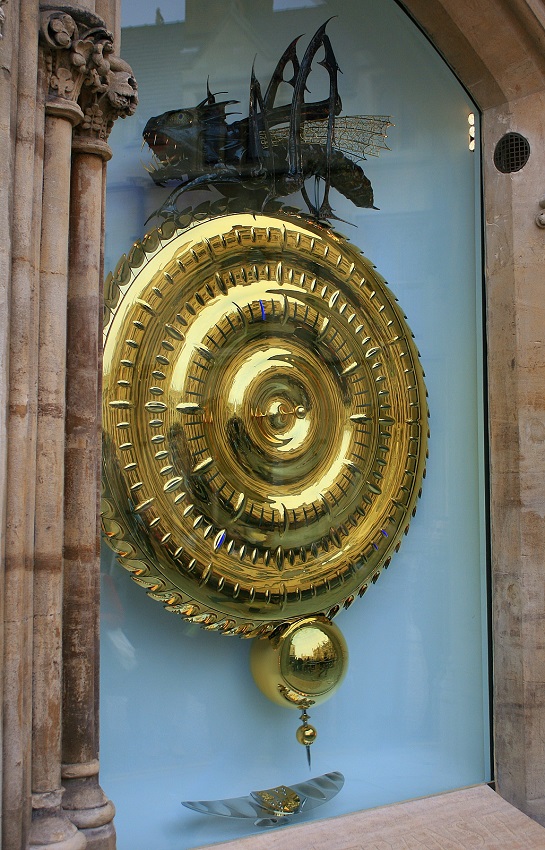
The Chronophage Corpus Clock in Cambridge – photo, Wikipedia (Rror)
During the Q&A session at the end of the presentations, there were some insightful and thought-provoking questions. I especially enjoyed discussion around how we as a society can ensure that the crucial skills around making and inventing can be retained, and just how important it is and that these skills can appear in the most unexpected of places – Rebecca Struthers made one point around a Professor who had once had to send his first year medical/surgery students on a sewing course as they didn’t have the skills to stitch up their patients!
In Summary
We had a really lovely evening at the Royal Academy of Engineering, and it was a real pleasure to have been invited along to the launch event of the Clocktime digital museum. It really is a tremendous resource, and I love that it has been born of a real passion for horology combined with a desire to share and inspire appreciation in these traditional skills.
It couldn’t have arrived at a better time, as artisanal clockmaking and watchmaking are categorised as endangered skills on the Heritage Crafts red list, and I really hope that Clocktime goes on to become a much-utilised resource and serves to inspire the younger generation.
Finally, a huge thank you to Rebecca Struthers for the kind invitation, and to Tina Fotherby and the Clocktime Team for permission to use the photography from the event.
Make sure you visit the Clocktime digital museum at www.clocktime.co.uk
If you have any questions, please get in touch via our Contact page, or via our Instagram.
You might also be interested in:
- Restoring an Heirloom Vintage Sagara Watch
- Recommended Reading: ‘Hands of Time – A Watchmaker’s History of Time’ by Rebecca Struthers
- A Visit to the Clockmakers’ Museum, London
- Watch Stationery and Gift Ideas
- Watch Books, Watch Boxes and more at the Watch Affinity Shop on Amazon (commissions earned)
As an Amazon Associate, I earn from qualifying purchases – thank you for your support

